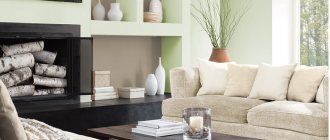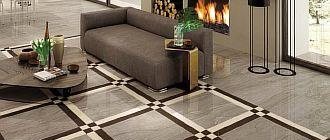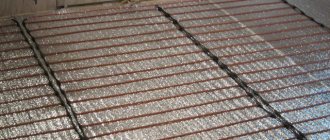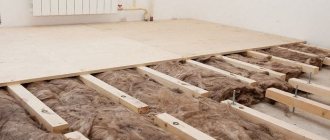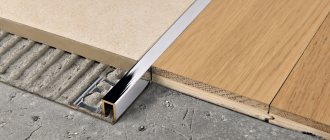The name porcelain stoneware is associated in the user's understanding with the grandeur of palace decoration, with the words granite, marble, strength. This material has nothing to do with natural stone and expensive finishing, but as for its appearance, porcelain stoneware could have been successfully used in the Middle Ages to decorate the chambers and chambers of kings.
By using this durable tile in the interior of the kitchen floor, every housewife will receive a beautiful appearance, a non-perishable coating and an easy-to-clean surface .
The production technology of porcelain stoneware is constantly being improved, which makes it possible to create new properties to improve consumer qualities and increase the number of use cases for designers. The technical characteristics of this future material distinguish it from other types of flooring.
This became possible thanks to a unique production technology
The first stage of production can be called sorting clay in a mining quarry. Clays are selected that have a strictly defined composition and are rich in ileite and kaolin. Quartz sand, also involved in production, is cleaned of mechanical and chemical impurities. The third component is feldspar and various coloring additives based on metal oxides, such as manganese, iron, chromium, cobalt.
All these types of materials are mixed in powerful mixers. For different types of future tiles, different ratios of components are determined. The mass is formed into semi-finished products for further processing.
The production of wear-resistant and frost-resistant tiles has been known for a long time, but only in the last ten years have technologies emerged that make it possible to produce modern porcelain tiles, which differ from ceramic tiles. The samples are subjected to a pressure of 450 kg per centimeter. Such powerful pressing removes absolutely all pores in the material , but at the end of the day, such tiles have a residual moisture content of 10%, which is removed during further drying.
So, samples with completely specified properties enter the firing chambers. Temperatures above 1200ºС can be confidently attributed to the latest achievements of technological innovation. At the same time, the samples are constantly in motion, which guarantees uniform sintering. The rise and fall of temperature occurs gradually. Inside the body of the tile, all chemical processes are completed, and the material is structured, forming a single durable product .
Finished porcelain stoneware products have dimensions of 200 mm x 200 mm, 300 mm x 300 mm, 400 mm x 400 mm and thickness from 7 to 12 mm.
No. 1. What is porcelain tile?
Porcelain stoneware is a very strong and durable type of facing covering, which can rightfully be considered a substitute for natural stone. The composition of porcelain stoneware includes such natural components as clay, mica, sand and feldspar, and a special additive in the form of granite chips gives this material special strength.
Porcelain stoneware is produced by pressing and sintering. All components are mixed together in the required proportions, pressed at a pressure of 400-500 kg/cm², and then subjected to high-temperature annealing in an oven (1200-1300°C). Using this technology, it was possible to achieve the absence of pores in the finished material and its high strength.
At first, porcelain stoneware was used as a floor covering in industrial premises with high loads; now technology has stepped far forward, which has made it possible to use porcelain stoneware not only as a floor covering in residential premises, but also for finishing walls and facades. We will look in more detail at those types of porcelain stoneware that are used specifically as flooring.
Choosing flooring: pros and cons of different options
The market offers for arranging the floor in an apartment are so diverse that making a choice is not easy. To get your bearings faster, we recommend using a simple technique. Determine which characteristics of the material should be the main ones for you according to at least 3 criteria: interior design, room features and installation conditions.
For example, you decided that you need a natural, moisture-resistant, easy-to-install material. Only 3 of the popular materials have these features - tiles, cork and porcelain stoneware. And then choose, comparing their pros and cons. Timur Abdrakhmanov, co-founder of the Quadrim repair service, talks more about the latter.
No. 2. Advantages of porcelain stoneware
The main advantages of porcelain stoneware:
- Environmentally friendly thanks to the use of natural ingredients.
- Low water absorption coefficient . Due to the almost complete absence of pores, porcelain stoneware does not absorb water, which makes it frost-resistant. Also, the absence of pores allows you to not be afraid that the adhesive mixture will seep onto the surface of the tile and ruin it, as sometimes happens with tiles.
- Chemical resistance, be it alkali or another acid, which makes it possible to clean it with absolutely any means.
- Wear resistance and high bending strength . Porcelain stoneware is such a durable material that it has a very high bending strength per m², which makes it possible to lay it even on uneven surfaces.
- Resistance to mechanical stress . The glossy surface of porcelain tiles does not lose its shine and is scratch resistant for many years.
- Color constancy . Porcelain stoneware is absolutely not affected by ultraviolet radiation, which allows it to maintain the clarity of the pattern and the brightness of the color even with prolonged exposure to the sun.
- Anti-slip coating . There is a matte, slightly rough variety of porcelain stoneware that will remain non-slip even when wet.
- Thermal conductivity . This material does not allow cold to pass through and retains heat well.
Finishing
A simple white or beige tiled splashback will transform a Provence-style kitchen.
Clinker tiles are a popular trend in the interior. It creates the effect of old or fresh brickwork. This solution makes the design elegant.
Tiles with photo printing - this material allows you to see almost any desired image on the surface. The design and glaze coating remain bright and fresh for a long time. The space takes on an exclusive design.
No. 3. Types of porcelain stoneware
The following types of porcelain stoneware are most suitable for flooring:
- Technical porcelain stoneware An ideal option for covering floors in industrial premises.
- Matte porcelain stoneware This type of porcelain tile does not lend itself to any additional changes after undergoing a heat treatment cycle. This makes its surface a little rough and discreet. But it has increased hardness and anti-slip properties.
- Polished porcelain stoneware A more capricious appearance than the previous one, it has a smooth, even surface, almost mirror-like, thanks to processing with abrasives. This treatment somewhat reduces its wear resistance. For a longer service life, it must be treated with special mastics, which create an additional protective layer on its surface. Otherwise, with prolonged use, polished porcelain tiles will gradually turn matte.
- Satin. This porcelain tile has an unobtrusive light shine, which is obtained by applying mineral salts to the surface before baking in the oven. This type of treatment does not affect wear resistance.
- Structured The type of porcelain tile has a relief surface, allowing you to imitate the texture of wood (parquet porcelain tile), leather or various types of stone. Visually and to the touch it is practically no different from natural materials.
- Glazed porcelain stoneware is produced by applying a special glaze to the surface and then firing it. The glazed surface is much stronger than conventional ceramic tiles, however, this type of porcelain tile is not recommended for use in rooms with high traffic and a high level of mechanical stress. Over time, it loses its visual appeal.
- Lapped Porcelain stoneware has a mixed texture - half polished, half matte. This effect is achieved by removing a thin, uneven top layer using special polishing stones. This type can be safely used for flooring in rooms with high traffic and high loads.
- Double backfill. The top layer of the tile, approximately 3 mm, is made from the components of the required colors, and the bottom layer is made from the main components. In this way, bright, colored tiles are obtained, the wear resistance of which remains at a high level.
No. 4. Classification of porcelain stoneware
- Size. The most popular sizes of tiles for flooring are square tiles with dimensions of 300x300 mm, 450x450 mm and 600x600 mm. If you have some kind of designer and unusual project in mind, and the floor will be the center of your interior, then you also have at your disposal tiles of the smallest size - 50x50 mm, and non-standard sizes - 200x200 mm, 150x300 mm, 300×450 mm, 300×600 mm, 400×400 mm. If you still haven't found the right size for you, you can get it using waterjet cutting .
- Caliber is the amount of permissible discrepancy in the size of the tiles, which is 3-5 mm. During the heat treatment, the edges of the tiles are slightly deformed, so they may differ from each other. To avoid large discrepancies in size, the tiles undergo a process of rectification , that is, trimming the edges using special equipment. match perfectly during subsequent installation .
- Thickness. The maximum thickness of porcelain stoneware is 30 mm, the minimum is 3 mm. With proper installation of a 3 mm thick floor covering, its strength and wear resistance are in no way inferior to a 30 mm thick covering, so there is no point in giving preference to the thickest, and therefore more expensive, porcelain stoneware. For example, recommended specifically for flooring, 8.5 mm , can withstand a load of 200 kg/cm2.
Abrasion class. Abrasion (wear resistance) is the main technical characteristic of porcelain stoneware. Depending on the degree of load and mechanical impact, there are 5 main classes of abrasion:
- PEI I, PEI II – for rooms with low traffic in soft shoes (bathroom, toilet);
- PEI III - for residential premises with an average level of traffic, without access from the street or yard (balcony, kitchen, hallway);
- PEI IV – for public spaces with high traffic levels;
- PEI V – for premises with any level of traffic and mechanical impact.
For example, for the floor covering in the entire apartment, abrasion class III is quite sufficient, and for the bathtub and toilet, class I or II can be used. If your task is to choose porcelain tiles for a private home, then choose class IV for the hallway, and for the porch give preference to class V, which is also frost-resistant. In other rooms, class III will also be sufficient.
Minuses
- Cold surface . Porcelain stoneware tiles are durable products, and like other materials related to this type, they are cold. This property is not suitable for everyone, which should be taken into account when choosing a coating.
- Difficulties in determining the quality of tiles . In the process of its manufacture, a technique is used in which the conditions and components of the material must be strictly observed. If something goes wrong, then ultimately the defective product will not be externally different from the genuine one. The parameter you can use to navigate is weight. One tile 8 millimeters thick should weigh 18 kilograms.
- Slippery tiles . The surface of porcelain tiles can be slippery, and having water on the surface will only make the situation worse. In regions where precipitation occurs most frequently, experts do not recommend choosing this type of material. It is best to use other options: matte or lapped.
- Fragility of the material . Despite its high strength, porcelain stoneware is very fragile due to the fact that it is not plastic. During transportation and installation, care must be taken not to damage the material.
- Hard and thick surface . This is both a plus and a minus at one point. If we are talking about places where a lot of movement is required, then this is a plus. The downside is that if you drop something on the floor, most likely the phone or cup or something else will not withstand the impact and will break.
- Porcelain tiles cannot “age gracefully . Porcelain tile is an artificially created material, and due to this it cannot “age gracefully.” For lovers of natural materials of natural origin, this quality is a priority, as they age beautifully and can be restored.
- Seams when laying . When laying porcelain tiles, seams cannot be avoided. If a seamless floor surface is more suitable for someone, then it is better to choose a different material. Also, many are unhappy with the fact that various debris often gets stuck in the seams, which requires effort when cleaning.
No. 5. Are porcelain tiles and tiles the same thing?
Many people mistakenly believe that these are really the same type of flooring, they just decided to shorten the name and raise the cost... But this is far from the case. differences significant ones at that :
- Porcelain stoneware undergoes heat treatment at significantly higher temperatures than tiles, which explains its higher strength and wear resistance .
- Due to high temperatures, the components of porcelain stoneware literally melt during processing, which completely eliminates the appearance of micropores . This prevents moisture from entering the internal structure, so porcelain stoneware can withstand high sub-zero temperatures without cracking. Tile has a porous structure and cannot withstand large temperature changes.
- Porcelain tiles are easy to clean - due to the absence of micropores, the surface becomes less dirty. A damp cleaning is enough to maintain its beautiful appearance.
- Porcelain tiles are absolutely resistant to any chemicals . This makes the cleaning process easier. Tile does not tolerate aggressive substances well and can lose its shine when exposed to, for example, alkali.
- Cracks and chips do not form on the surface of porcelain stoneware, even after a long time . Despite the fact that on tiles you can observe microcracks on the surface after just a couple of years of use.
- Porcelain tiles, due to their resistance to ultraviolet radiation , will not lose their color and clarity of design even after 50 years, which cannot be said about tiles, which fade over time.
- practically no stains . Have you noticed that when laying tiles, the adhesive mixture sometimes appears on the surface and has to be changed, since this is an irreversible process? This will never happen with porcelain stoneware due to its monolithic structure . Even if you spill a coloring substance on the surface of porcelain stoneware, it can be easily removed without leaving a trace.
- Porcelain stoneware has a high bending resistance , which allows it to be laid even on uneven surfaces. The tile breaks at the slightest distortion.
- The best porcelain tiles have absolutely smooth and clear edges, which allows you to perform seamless styling.
No. 6. Application area
Due to the variety of colors and textures and their constancy, resistance to mechanical damage and chemicals, frost resistance and bending resistance, porcelain stoneware is used for cladding walls and floors both indoors and outdoors . Due to its high levels of hardness and abrasion, this is an ideal type of coating for industrial and public spaces. It will also be used for finishing halls, swimming pools, floors in cafes and even at train stations. After all, this material is truly eternal, and the ability to produce in various sizes makes it almost universal . Whatever room comes to your mind, you can always choose the necessary type of porcelain stoneware. Porcelain tiles even replaced parquet! Both visually and to the touch it does not differ at all from natural wood.
Coating care
Caring for porcelain stoneware floors is simple, but requires some knowledge.
- Do not use powders with abrasive particles for cleaning, especially polished and glazed floors.
- These same two types of coating must be treated with water-repellent agents . Due to grinding, the surface becomes partially vulnerable.
- If it is necessary to clean stains of paint, tar, or old grease, use various solvents, acetone, white spirit, and grease.
- When washing porcelain stoneware floors every day, add a weak solution of soda ash or chlorine to the water to soften it.
No. 7. Disadvantages of porcelain stoneware
Despite a number of significant advantages, like any material, porcelain stoneware also has disadvantages
- Porcelain tiles are able to prevent the penetration of cold and retain heat, but this material itself is cold , just like tiles. The solution is to use heated floors.
- All types of porcelain tiles, except technical, matte and structured, will be slippery .
- Of course it is worth noting high price porcelain tiles compared to tiles. But in this case you can bet, because it’s better to spend once and get coverage with a guarantee of 50 years or morethan constantly replacing cracked or faded tiles. Moreover, there are now many types of porcelain tiles available from different manufacturers with different pricing policies. The highest price is for Italian porcelain stoneware, but there are also Belarusian, Turkish, Greek and Baltic ones, which allows you to select the material with the best price-quality ratio.
Famous manufacturers
Over the past 10 years, porcelain tile manufacturers in Russia have reached new heights. Domestic products are in no way inferior to foreign ones in quality, but their prices are much lower. Their leaders have been identified - according to experts and consumer assessments:
KeramaMarazzi
An international brand, a recognized industry leader. It has been producing porcelain stoneware since 2006, using dry pressing technology. Much attention is paid to the most accurate recreation of natural material and environmental issues.
ESTIMA Ceramica
One of the best manufacturers on the market, operating since 2001. The product stands out for its high quality workmanship and affordable price.
No. 8. What should you pay attention to when purchasing?
- Before purchasing, you need to already know what size tiles you want . This way you can easily figure out their quantity by dividing the desired coverage area by the area of one tile.
- Please note that all tiles match in color and shade . All tiles must be from the same batch, otherwise the difference in shade will be very noticeable after installation!
- The caliber of all tiles should also be the same - this will ensure a beautiful, uniform installation without visible differences in size.
- Be sure to check the weight ! The recommended tiles for flooring are 8-8.5 mm thick and weigh at least 18.5 kg. Do not hesitate to clarify this point, otherwise you risk buying a fake!
- The back side of the tile can also say a lot. It should have shallow, small squares with sides of a maximum of 2x2 cm. The larger and deeper these technical notches are, the lower the quality of the material.
- Do not forget about the reserve , which should be 10% of the total number of tiles for the diagonal laying method and 5% for other methods.
- The packaging of porcelain tiles for flooring will show foot on a black background, if this sign is repeated, it means a higher wear resistance class. If you see snowflake - This is a frost-resistant porcelain stoneware.
No. 9. Features of laying porcelain stoneware
If you decide to refuse the expensive services of professionals and decide to install porcelain stoneware yourself , you should approach this issue very carefully, because the durability of the coating will depend on the correct installation.
Porcelain stoneware, as a very durable material, is very difficult to cut, so that you do not have any difficulties or surprises during the installation process, prepare all the necessary tools :
- You will definitely need a tile cutter or grinder
- Required building level
- A spatula with a smooth edge is for applying the adhesive mixture and a spatula with a serrated edge is for removing excess mortar.
- A construction bucket or other convenient container for mixing the adhesive mixture
- Drill and special construction mixer to facilitate the mixing process
- Water container
- Rubber hammer
- Plastic crosses, which regulate the width of the seam, are chosen to your taste
Since porcelain stoneware is very heavy, it is necessary to choose a mixture that will withstand heavy loads. It is better to choose a plastic adhesive mixture with high “tenacity”; in addition, it prevents the tiles from falling off if your house is not yet fully settled and “walks” when temperatures change or the foundation settles. When the adhesive mixture is selected, move on to the next step.
Surface preparation
Although porcelain stoneware provides for differences of up to 15 mm, it is better to pre-level the surface by pouring concrete, pre-waterproofing, and then carefully prime it . If porcelain tiles are laid on a heated floor, then the sequence will be as follows - waterproofing the room, laying a heated floor, pouring concrete (screed), impregnating with soil, laying porcelain tiles. By the way, installation on old wooden floors is not allowed . After preparing the surface, you can proceed to the mixture. Stir the adhesive mixture according to the instructions on the package. If you are laying tiles for the first time, you should not mix the whole mixture at once, in case you will have difficulties in the process, and the mixture does not retain its adhesive properties for so long. It’s better to start by diluting a small amount, literally a couple of tiles, and try to lay them, thereby testing your capabilities.
User reviews
Our kitchen, living room and hallway are lined with the same ceramic granite, we have been using it for 6 months. It was cold in winter, the heated floor was always turned on. Now in the summer it’s even nice for my feet to be on the cool floor; I always just walk barefoot. From the comments - we laid a light floor, everything is visible on it! And it’s better not to drop dishes on it.
Ivan, Magnitogorsk
We have porcelain tiles in the hallway and kitchen. I practically don’t use heated floors under it, maybe in cold weather I’ll turn it on, of course, it’s quite warm (as far as this word is applicable for such a surface) even without warming up with a heated floor, it’s pleasant to walk on. It differs from tiles in thickness and resistance to breaking, so lay it and don’t hesitate!
Maria, Moscow
I visited where the entire apartment, except for the bedrooms, was made of porcelain stoneware with partial heated floors.
I really liked the feeling of bare feet on the comfortable tiles and it doesn’t bother me visually at all (but there is such a sharp contrast on the floor in the bathroom and bedrooms in winter compared to the rest of the apartment). We will also install porcelain tiles in the hallway, living room, kitchen, loggia and bathroom, with heated floors, and in the bedroom there is a warm cork floor without heating. Mikhail, Novgorod

